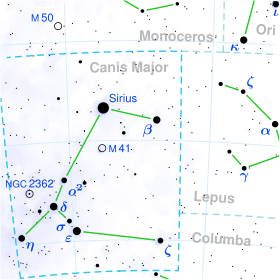Iota Canis Majoris
| Observation data Epoch J2000 Equinox J2000 | |
|---|---|
| Constellation | Canis Major |
| Right ascension | 06h 56m 08.22459s[1] |
| Declination | −17° 03′ 15.259″[1] |
| Apparent magnitude (V) | 4.40[2] (4.36 - 4.40[3]) |
| Characteristics | |
| Spectral type | B3 Ib[4] or B3 Ib/II[5] |
| U−B color index | −0.74[6] |
| B−V color index | −0.07[6] |
| Variable type | Beta Cephei?[2] |
| Astrometry | |
| Radial velocity (Rv) | 41.75±0.43[1] km/s |
| Proper motion (μ) | RA: −3.547 mas/yr[1] Dec.: 3.19 mas/yr[1] |
| Parallax (π) | 0.9453 ± 0.1857 mas[1] |
| Distance | 3,100±130 ly (950±40 pc)[7] |
| Absolute magnitude (MV) | −5.51[8] |
| Details[7] | |
| Mass | 13.7±0.5 M☉ |
| Radius | 32±4 R☉ |
| Luminosity | 52,480 L☉ |
| Surface gravity (log g) | 2.59±0.05 cgs |
| Temperature | 15,600±400 K |
| Metallicity [Fe/H] | −0.17[9] dex |
| Rotational velocity (v sin i) | 30±6 km/s |
| Age | 14.79+1.43 −1.30 Myr |
| Other designations | |
| Database references | |
| SIMBAD | data |
Iota Canis Majoris, Latinized from ι Canis Majoris, is a solitary[10] variable supergiant star in the southern constellation of Canis Major. It is visible to the naked eye with an apparent visual magnitude that varies between +4.36 and +4.40.[3] The distance to this star is approximately 2,500 light years based on spectroscopic measurements.[7] It is drifting further away with a radial velocity of +42 km/s.[1]

Iota Canis Majoris is a massive blue-white B-type supergiant with a stellar classification of B3 Ib.[4] It has been classified as a Beta Cephei type variable star,[3] but the supergiant spectral type and a period of over a day mean it is no longer considered to be of that type.[2] This star is 15 million years old and is spinning with a projected rotational velocity of 30 km/s. It has 14 times more mass and 32 times the radius of the Sun. Iota Canis Majoris is radiating 52,000 times the luminosity of the Sun from its photosphere at an effective temperature of 15,600 K.[7]
The star displays a bow shock feature from its interaction with the interstellar medium, but this nebulosity is not aligned with the star's motion through the galaxy.[12]
References
[edit]- ^ a b c d e f Vallenari, A.; et al. (Gaia collaboration) (2023). "Gaia Data Release 3. Summary of the content and survey properties". Astronomy and Astrophysics. 674: A1. arXiv:2208.00211. Bibcode:2023A&A...674A...1G. doi:10.1051/0004-6361/202243940. S2CID 244398875. Gaia DR3 record for this source at VizieR.
- ^ a b c Stankov, Anamarija; Handler, Gerald (2005). "Catalog of Galactic β Cephei Stars". The Astrophysical Journal Supplement Series. 158 (2): 193–216. arXiv:astro-ph/0506495. Bibcode:2005ApJS..158..193S. doi:10.1086/429408. ISSN 0067-0049. S2CID 119526948.
- ^ a b c Samus, N. N.; Durlevich, O. V.; et al. (2009). "VizieR Online Data Catalog: General Catalogue of Variable Stars (Samus+ 2007-2013)". VizieR On-line Data Catalog: B/GCVS. Originally Published in: 2009yCat....102025S. 1: 02025. Bibcode:2009yCat....102025S.
- ^ a b Prinja, R. K.; Massa, D. L. (2010). "Signature of wide-spread clumping in B supergiant winds". Astronomy and Astrophysics. 521: L55. arXiv:1007.2744. Bibcode:2010A&A...521L..55P. doi:10.1051/0004-6361/201015252. ISSN 0004-6361. S2CID 59151633.
- ^ Houk, Nancy; Smith-Moore, M. (1978). Michigan catalogue of two-dimensional spectral types for the HD stars. Vol. 4. Ann Arbor: Dept. of Astronomy, University of Michigan. Bibcode:1988mcts.book.....H.
- ^ a b Mermilliod, J.-C. (1986). "Compilation of Eggen's UBV data, transformed to UBV (unpublished)". Catalogue of Eggen's UBV Data. Bibcode:1986EgUBV........0M.
- ^ a b c d Weßmayer, D.; Przybilla, N.; Butler, K. (2022-12-01), "Quantitative spectroscopy of B-type supergiants", Astronomy & Astrophysics, 668: A92, arXiv:2208.02692, Bibcode:2022A&A...668A..92W, doi:10.1051/0004-6361/202243973, ISSN 0004-6361
- ^ Balona, L. A.; Engelbrecht, C. A. (1985). "Photometry and frequency analysis of line profile variables". Monthly Notices of the Royal Astronomical Society. 214 (4): 559. Bibcode:1985MNRAS.214..559B. doi:10.1093/mnras/214.4.559.
- ^ Gies, Douglas R.; Lambert, David L. (1992). "Carbon, nitrogen, and oxygen abundances in early B-type stars". Astrophysical Journal. 387: 673. Bibcode:1992ApJ...387..673G. doi:10.1086/171116.
- ^ Eggleton, P. P.; Tokovinin, A. A. (September 2008). "A catalogue of multiplicity among bright stellar systems". Monthly Notices of the Royal Astronomical Society. 389 (2): 869–879. arXiv:0806.2878. Bibcode:2008MNRAS.389..869E. doi:10.1111/j.1365-2966.2008.13596.x. S2CID 14878976.
- ^ "MAST: Barbara A. Mikulski Archive for Space Telescopes". Space Telescope Science Institute. Archived from the original on 27 March 2023. Retrieved 29 September 2024.
- ^ Bodensteiner, J.; Baade, D.; Greiner, J.; Langer, N. (October 2018). "Infrared nebulae around bright massive stars as indicators for binary interactions". Astronomy & Astrophysics. 618: 13. arXiv:1806.01294. Bibcode:2018A&A...618A.110B. doi:10.1051/0004-6361/201832722. S2CID 118972162. A110.

